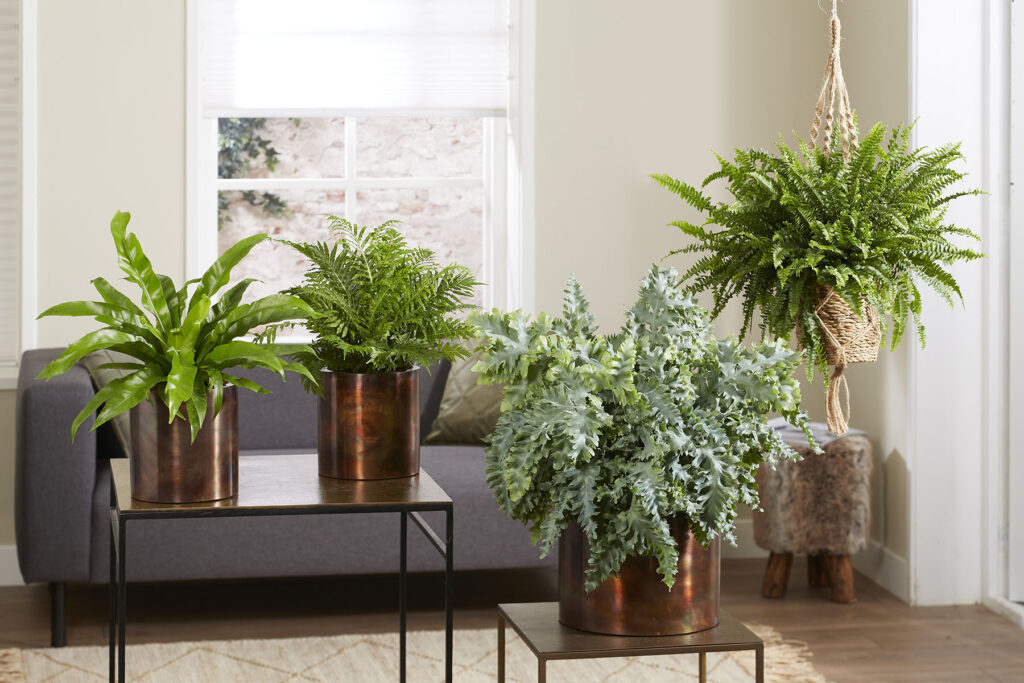“Ferns should be in a place where you like to be yourself: not too hot and not too humid.” With this statement, Kelly Raadschelders clears up a persistent misunderstanding. Ferns don’t need much moisture and heat at all. Together with her parents and her brother, she preserved the cultivation of ferns. Today, they are the market leader and she gives us a look behind the scenes.
From roses to ferns
The story of the nursery begins in 1982. Jan and Joke Raadschelders first grew roses, but soon replaced that crop with ferns. “Growing roses is labour-intensive. Besides, there was an energy crisis in the 1980s,” Kelly explains. “And so my parents switched to ferns. Nephrolepis Boston in pot size 13 was the first species. For years, that remained the only species in the range. In 1995, my father took over a second nursery at the Zevenhoven location.”
In 2003, they left Kudelstraat and invested in a new building on the De Kwakel site. A turning point. Until then, they grew one variety in two different pot sizes, but modernisation opened new doors. It is also around this time that children Kelly and Sander decide to join the business. “For me, that was not a done deal,” Kelly explains. “Even though I grew up among the ferns, so to speak, my ambition lay elsewhere. For instance, I first studied Tourism. But when we were about to invest in the new site, I still decided to get into the business together with my brother.”
Wide range and own variety
In 2018, the next generation will take over, although Jan and Joke still lend a hand every day. Meanwhile, the range of ferns has grown considerably and, with outlets all over the world, Raadschelders is the market leader. How do they differentiate themselves from other growers? “Our range is very broad,” Kelly explains. “We looked carefully at what the market needed and put together the assortment in close consultation with the cutting supplier. Because we have such an extensive range in various pot sizes, we are very attractive to customers. They can order different varieties in the desired quantities from us.
About five years ago, we grew our own variety: the Phlebodium Davana, named after my daughters (Da=Daisy, Va=Silva, Na=Naomi). A hit because we won the Royal Flora Holland Glass Tulip in 2020 with this variety.”
Air So Pure
Raadschelders’ ferns stand out not only for their leaf colour, original shapes and shelf life. A number of species score very high on air-purifying properties. “Together with other growers, we are affiliated with Air So Pure. This growers’ organisation focuses on plants whose air-purifying properties have been scientifically proven. With the brand promise ‘A world of wellbeing’ and a contemporary look, Air So Pure informs consumers about the positive effects of their plants, both physically for the indoor climate and mentally. A valuable collaboration, as they bring this story to consumers with matching promo material.”
Right choices through right collaborations
It is through such collaborations that you grow as a grower and can make the right choices. This also applies to the collaboration with Floréac. “When we want to launch a new variety on the market, it is always exciting to see if it does well. A partner like Floréac is an indispensable link here. With which customers will a certain type of fern do well? What pot sizes should we provide? Because Floréac shares all that data with us, we can make better decisions. We consult a lot and it’s nice to notice that you are on the same wavelength. I hope we can continue in the same vein for a long time.”
Ferns and water: what about it?
And then it’s time to dispel a myth. Do ferns need a lot of water and heat? “Not at all,” denies Kelly. “Ferns want to be where you want to be as a human: not too hot, not too cold, not too wet or too dry and not too draughty. We grow quite dry which makes the build-up a nice full plant. The more water we can save, the better, because sustainability is an important pillar.”

Sustainable improvement
“For instance, we are certified with MPS-GAP, GLOBALG.A.P. with additional GRASP and we are doing a footprint calculation. This involves tracking data on our crop protection, use of plastic and so on. Afterwards, we can then see where there are areas for improvement. Anyway, we hardly need any crop protection and if we do, we opt for natural ones. Furthermore, we have invested in double screens, try to minimise the use of plastic and grow as much peat-free as possible.
Unfortunately, you can’t control everything. We generate electricity through solar panels and would like to go completely gas-free. But the environment here does not allow geothermal energy. We are now fully exploring whether we can become more sustainable in other ways, for instance by taking residual heat from large companies.”
Future in ferns
Growing gas-free is already one of the intentions. But Raadschelders is not sitting still. “There are some new varieties of ferns in the pipeline. And one day we hope to centralise the entire production on one site.”
And finally, what still attracts Kelly most after all these years in the industry? “The variety. One day I’m working on new certificates and the next day on trade shows. I’m also quite proud of our products. They feel tropical and immediately brighten up your interior. Also the idea that our Phlebodium davana is in New Zealand somewhere in someone’s home. How special is that?”
